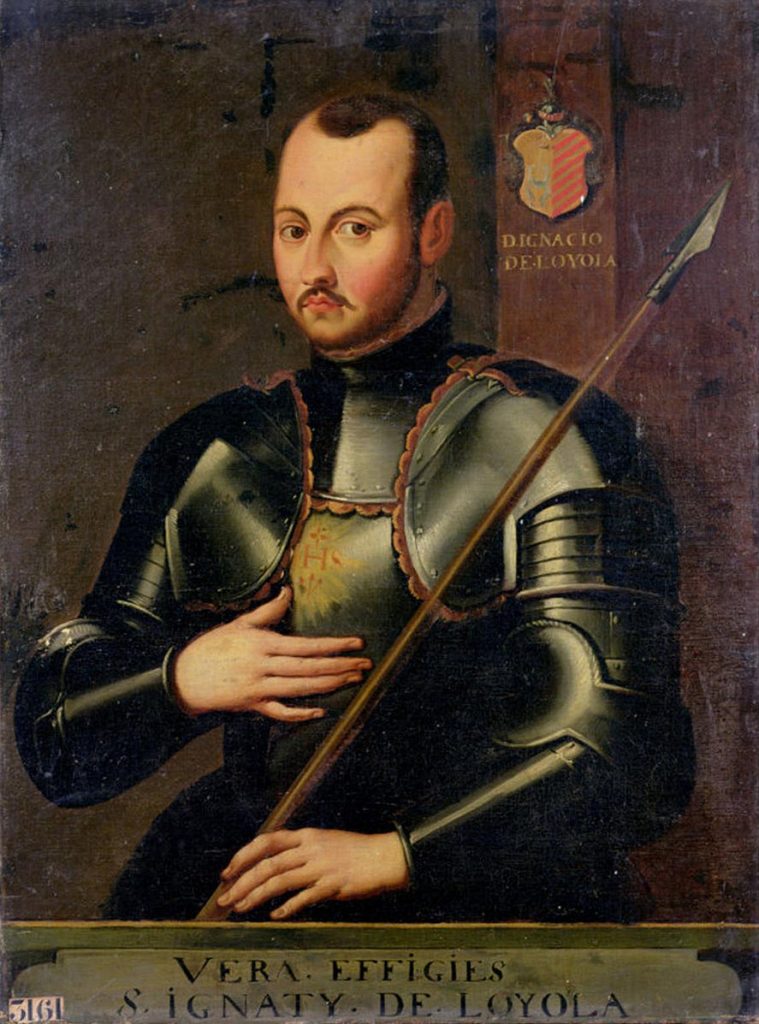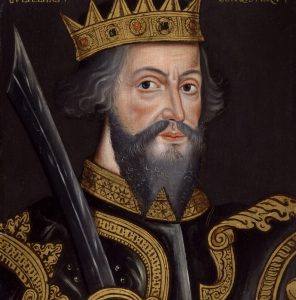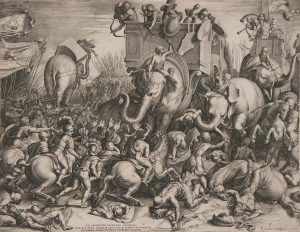St. Ignatius was a Spanish priest who founded the Society of Jesus, or Jesuit Order, in 1540. He intended the society to be servants of the pope, and therefore of the universal Catholic Church. The Jesuits have been given credit for responding to the Protestant Reformation and for winning back to the Catholic fold many of the people who had left the church.1 St. Ignatius, known as Inigo in Spanish, lived a life of chivalry in his early years. Before devoting his life to God, he was a dedicated solider, and it wasn’t until he came to a near death experience that he decided to change his life.
In 1521, Ignatius was a soldier fighting to defend the Spanish city of Pamplona alongside his master Antonio de Manrique, the Duke of Nájera, against the French. Negotiations began between the besieged Spanish and the French military leaders, and when talk of surrendering to the French came up, Ignatius was furious at the weakness of his Spanish negotiators. He wanted to defend the city or die trying.2 The French proceeded to attack the city. Unfortunately, Ignatius was shot by a cannon and was seriously injured. The cannonball had struck his legs and seriously damaged one of them. Fortunately, some French soldiers tended to his damaged leg. The soldiers saved his leg from amputation, so in return, Ignatius gave away his shield, corset, and dagger to the French soldiers. From the battlefield, Ignatius was transported to northern Spanish town of Anzuola to recover.

When Ignatius arrived in Anzuola, the doctors decided that it would take multiple surgeries to help him. First, they decided that his leg had to be broken again and his bones reset. During the first operation, Ignatius did not utter a single sound, and the only indication of pain he gave was clinched fist. The operation brought Ignatius to near death. He was advised to confess his sins to a priest, and was told that if he did not feel better, he could consider himself a dead man. That night Ignatius prayed to St. Peter and later that night he started to feel better. However, something went wrong during the second surgery. As the bones in his right leg settled, a piece of the bone had started to push itself forward from his knee creating a stub.3 Ignatius immediately demanded another operation be performed. Ignatius believed that life had no purpose if he could not prove his courage to women or wear the elegant knee-boots of the hidalgo.4 The doctors advised against this, but Ignatius insisted. Again, he did not utter a single sound during the very painful surgery. The surgery was a success, but Ignatius remained bedridden for months. When he was well enough to read, he requested books of chivalry, but there were no books of that kind in the castle. Instead, he was given The Life of Christ and The Lives of the Saints.
These two books had a great impact on his life. At first, Ignatius read these books in disgust. He dismissed the saints for the penances they performed. Slowly, the nobility of their actions grew on him. He was able to find things that he admired about them. One saint that caught Ignatius’s eye was Saint Francis. He admired St. Francis’ courage, his love of dancing, his singing, and his love for nature. These books changed the way he thought about life. He wanted to be a working servant of Christ, like St. Francis had been. While he was recovering, he saw a vision of Mary, the mother of God, and was filled with joy. This vision of Mary made Ignatius completely devote his life to God.
After he had recovered, he gave all his clothes away and became a hermit and focused on helping the sick. He wrote about his experiences, which eventually became known as the Spiritual Exercises. He knew he would need an education to help convert people, so he went to Barcelona to further his education. He became a priest in 1537. In his earlier life he had been a faithful and dedicated solider, and now he brought those same characteristics to his life in the priesthood. In 1540, Pope Paul III confirmed the formation of the Society of Jesus. Ignatius led the Jesuits along the lines of his military experience, but instead of fighting on military battlefields, they were to dedicate their military-like focus to serving the interests of God and to converting people back to the Roman church. When Ignatius died in 1556, there were one-thousand Jesuits working in Europe, Asia, and the Americas.5 The Jesuits have been known ever since for their strong belief in education and for their missionary work. Today, Jesuits can be found throughout the world, contributing to their missionary work and to their many schools.
- Salem Press Biographical Encyclopedia, 2005, s.v. “Saint Ignatius of Loyola,” by Carol S. Berg. ↵
- Hugo Rahner, St. Ignatius of Loyola: a pictorial biography (Chicago: H. Regency, 1995), 14. ↵
- Hugo Rahner, St. Ignatius of Loyola: a pictorial biography (Chicago: H. Regency, 1995), 14. ↵
- Philip Caraman, Ignatius Loyola: a biography of the founder of the Jesuits (San Francisco, California: Harper & Row, 1990), 26. ↵
- Salem Press Encyclopedia, 2015, s.v. “Society of Jesus (religious order),” by Rebecca Kraft Rector. ↵



46 comments
Tyler Thompson
This was a very well written article, it was entertaining to read that St. Ignatius was kind of like a lady’s man, and tried very hard to appeal to them before becoming a hermit. I found it interesting that he prayed to St. Peter to help him through his operations, yet when he read the books about Saints, he read them in disgust. It’s amazing though that through small interventions, people can have a change at heart and live completely different lives.
Arianna Kennet
I have read about saints before but not about this particular one. It is interesting to see how saint Ignatius went from being a knight to a priest, both having similar morals and principles in a way. Saint Ignatius is a very brave and courageous person as was shown even during the period of time he was going through his surgeries, where he did not utter a sound or mourn in pain. He is someone that can definitely be looked up to.
Timothy ODekirk
I have always heard of Saint Ignatius of Loyola, mainly because of all the Jesuit schools that are named after him. I found this story of Saint Ignatius truly fascinating. I loved the story of how he was once a chivalrous Spanish knight to a faithful Spanish priest. I admire the fact how Ignatius was willing to convert himself to God and how he influenced many other Jesuits to do so. Furthermore, I find it a little disturbing about the whole surge process and how gruesome it was. But, all in all, that only made the story of Saint Ignatius a truly fascinating one at that.
Samuel Ruiz
I found great interest in the focus on Catholic faith in this article. After Ignatius’ conversion following his near-death experience, he found himself embarking on a life devoted to spiritual warfare rather than physical warfare. Similar to his new motives, many Catholics, such as myself, are finding themselves protecting the Church in their own ways. Additionally, I had only merely heard f the Jesuits but now that I understand their origin, I find greater interest in the group.
Tyler Sleeter
Very interesting article. At first, I just assumed that Ignatius was just another knight that fought for God instead of the local nobles. But after reading this article, I have a whole new perspective on St. Ignatius. I did not know he was the founder of the Jesuits nor that he had suffered so many surgeries. I find that it interesting that the only books available for him to read during his recovery were two religious books that changed his whole life. What would have happened if those books had not been present?
Michelle Falcon
Having attended a Catholic Private school for most of my life, I have had to study many different saints and their life stories. However I had never really known the story of St. Ignatius of Loyola before. To read about how te power pf prayer helped to heal him is amazing to me. The article also told how at first he wasn’t a religious person till his near death experience. This was a very well written article.
barros
Youre so cool! I dont suppose Ive learn something like this before. So good to find someone with some unique ideas on this subject. realy thank you for beginning this up. this website is something that is needed on the internet, somebody with just a little originality. useful job for bringing something new to the web!
Valeria Hernandez
Mario De Leon does a great job at explaining the journey of St. Ignatius. De Leon describes St. Ignatius transition from a soldier to a priest giving readers a good understanding of the priest determination. This article dissects a specific event of St. Ignatius life and explains it with great detail. Providing readers with a deeper understanding of a known saints transformation.
Maria Callejas
This was a terrific article! First of all, great title! My brother is a big fan of St. Ignatius, now I understand why he admires him so much. I had no idea he founded the Jesuit order, how proud he must be that Pope Francis is one! It is amazing to think, that the books he didn’t want to read ended up changing his life drastically. You make a great comparison in your article’s conclusion when you say how he brought his knight characteristics into his religious path, making him an exemplary priest and educator. Great job!
Evelin Joseph
It was great to hear the story of a saint and what exactly took place in his life in order for them to choose that life. It was surprising to hear that a man so devoted to being a soldier was able to transform and become a man only dedicated to God. He definitely suffered in his life, with two surgeries and their recovery periods, but it was inspiring to read that he was able to take these experiences and use them to make himself stronger in his faith. It was great to know more about the Jesuits and their origins. It was also great to learn about the strong saint that led them in serving God.